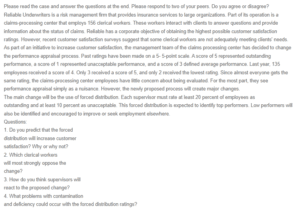The Reliable Underwriters Discussion
-
Do you predict that the forced distribution will increase customer satisfaction? Why or why not?
Whereas Reliable Underwriters needs to change employee appraisal processes, forced distribution will not yield enhanced customer satisfaction. The major problem is likely to occur when applying a bell curve. Whereas a bell curve is expected to yield similar results for random employee teams (1000-1500), the results may differ for small teams (Stewart et al. 173). It is unfair to expect the team at Reliable Underwriters (150 employees) to constitute the same number of underperformers as a team with ten times more employees. Instead, employees will be dissatisfied with the process since they know they may be rated poorly.
-
Which clerical workers do you think will most strongly oppose the change?
According to Stewart et al. (174), employees who have historically received poor ratings tend to oppose the system. Such employees believe that the system creates permanent employee classes. Therefore, those who have perpetually underperformed will be poorly rated even if they improve.
-
How do you think supervisors will react to the proposed change?
Managers and supervisors generally negatively react to the forced distribution appraisal system compared to traditional methods. Since the method has poor employee ratings, supervisors feel that holding them into the system will make employees perceive them as unfair leaders (Stewart et al. 173). Besides, they may reject the system due to its vulnerability to poor management by senior managers.
-
What problems with contamination and deficiency could occur with the forced distribution ratings?
Contamination and deficiency refer to the low validity of performance appraisals organizations use to rate their employees. Forced distribution introduces unfair comparisons between roles that do not agree, thereby compromising the outcome of the entire appraisal exercise. For instance, it is unfair to compare the roles of a Vice President and an Administrative Assistant using the same bell curve.
Work Cited
Stewart, Susan M, et al. “Forced Distribution Performance Evaluation Systems: Advantages, Disadvantages and Keys to Implementation.” Journal of Management & Organization, vol. 16, no. 1, Mar. 2010, pp. 168–179, 10.5172/jmo.16.1.168.
ORDER A PLAGIARISM-FREE PAPER HERE
We’ll write everything from scratch
Question

The Reliable Underwriters Discussion
Reliable Underwriters Discussion A
Please read the case and answer the questions at the end. Please respond to two of your peers. Do you agree or disagree?
Reliable Underwriters is a risk management firm that provides insurance services to large organizations. Part of its operation is a claims-processing center that employs 156 clerical workers. These workers interact with clients to answer questions and provide information about the status of claims. Reliable has a corporate objective of obtaining the highest possible customer satisfaction ratings. However, recent customer satisfaction surveys suggest that some clerical workers are not adequately meeting clients’ needs.
As part of an initiative to increase customer satisfaction, the management team of the claims processing center has decided to change the performance appraisal process. Past ratings have been made on a 5- 5-point scale. A score of 5 represented outstanding performance, a score of 1 represented unacceptable performance, and a score of 3 defined average performance. Last year, 135 employees received a score of 4. Only 3 received a score of 5, and only 2 received the lowest rating. Since almost everyone gets the same rating, the claims-processing center employees have little concern about being evaluated. For the most part, they see performance appraisal simply as a nuisance. However, the newly proposed process will create major changes.
The main change will be the use of forced distribution. Each supervisor must rate at least 20 percent of employees as outstanding and at least 10 percent as unacceptable. This forced distribution is expected to identify top performers. Low performers will also be identified and encouraged to improve or seek employment elsewhere.
Questions:
1. Do you predict that the forced
distribution will increase customer
satisfaction? Why or why not?
2. Which clerical workers
will most strongly oppose the
change?
3. How do you think supervisors will
react to the proposed change?
4. What problems with contamination
and deficiency could occur with the forced distribution ratings?


